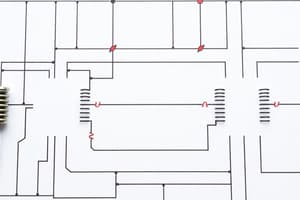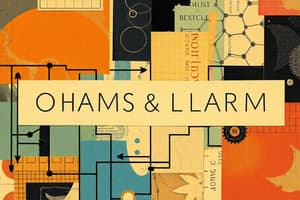Podcast
Questions and Answers
In a series circuit, what happens to the total resistance as more resistors are added?
In a series circuit, what happens to the total resistance as more resistors are added?
- The total resistance decreases
- The total resistance increases (correct)
- The total resistance stays the same
- The total resistance becomes zero
What happens to the voltage in a parallel circuit as more components are connected in parallel?
What happens to the voltage in a parallel circuit as more components are connected in parallel?
- The voltage across each component increases
- The total voltage becomes zero
- The total voltage remains the same (correct)
- The voltage across each component decreases
What does Ohm's law help calculate in a parallel circuit?
What does Ohm's law help calculate in a parallel circuit?
- Total voltage
- Total power
- Total current
- Total resistance (correct)
What is the relationship between the current in a series circuit and the current in each component?
What is the relationship between the current in a series circuit and the current in each component?
What happens to the total current in a parallel circuit as more branches are added?
What happens to the total current in a parallel circuit as more branches are added?
Which law is used to determine the voltage and current in a circuit with complex series and parallel connections?
Which law is used to determine the voltage and current in a circuit with complex series and parallel connections?
What is the total circuit resistance in a parallel circuit?
What is the total circuit resistance in a parallel circuit?
What is the total circuit resistance in a series circuit?
What is the total circuit resistance in a series circuit?
Why is it easy to misapply Ohm's law equations when analyzing complex series and parallel circuits?
Why is it easy to misapply Ohm's law equations when analyzing complex series and parallel circuits?
What must always be the same at any given time in a parallel circuit?
What must always be the same at any given time in a parallel circuit?
What should be done to cross-check results and minimize confusion when analyzing circuits with Ohm's law and Kirchhoff's laws?
What should be done to cross-check results and minimize confusion when analyzing circuits with Ohm's law and Kirchhoff's laws?
In a series circuit, what is the total voltage?
In a series circuit, what is the total voltage?
What is the total circuit resistance in a parallel circuit with only two sets of electrically common points?
What is the total circuit resistance in a parallel circuit with only two sets of electrically common points?
Why is it important to follow guidelines and methods for analyzing circuits with Ohm's law and Kirchhoff's laws?
Why is it important to follow guidelines and methods for analyzing circuits with Ohm's law and Kirchhoff's laws?
What is the total circuit resistance in a parallel circuit where the total resistance is only 625 Ω?
What is the total circuit resistance in a parallel circuit where the total resistance is only 625 Ω?
What happens to the total circuit resistance in a series circuit as more resistors are added?
What happens to the total circuit resistance in a series circuit as more resistors are added?
Flashcards
Series Circuit
Series Circuit
A circuit where components are connected end-to-end, forming a single path for current flow.
Parallel Circuit
Parallel Circuit
A circuit where components are connected side-by-side, providing multiple paths for current flow.
Current in Series Circuit
Current in Series Circuit
The same current flows through all components in a series circuit.
Voltage in Series Circuit
Voltage in Series Circuit
The total voltage across a series circuit is the sum of the individual voltage drops across each component.
Signup and view all the flashcards
Resistance in Series Circuit
Resistance in Series Circuit
The total resistance of a series circuit is the sum of the individual resistances of each component.
Signup and view all the flashcards
Voltage in Parallel Circuit
Voltage in Parallel Circuit
The voltage across each component in a parallel circuit is the same.
Signup and view all the flashcards
Current in Parallel Circuit
Current in Parallel Circuit
The total current flowing into a parallel circuit is the sum of the individual currents flowing through each branch.
Signup and view all the flashcards
Conductance in Parallel Circuit
Conductance in Parallel Circuit
The total conductance of a parallel circuit is the sum of the individual conductances of each branch.
Signup and view all the flashcards
Ohm's Law
Ohm's Law
Describes the relationship between voltage, current, and resistance in a circuit: V = IR.
Signup and view all the flashcards
Kirchhoff's Current Law (I-law)
Kirchhoff's Current Law (I-law)
The total current entering a junction in a circuit must equal the total current leaving the junction.
Signup and view all the flashcards
Kirchhoff's Voltage Law (V-law)
Kirchhoff's Voltage Law (V-law)
The sum of all voltages around any closed loop in a circuit must equal zero.
Signup and view all the flashcards
Resistance in Parallel Circuit
Resistance in Parallel Circuit
The total resistance of a parallel circuit is less than the resistance of any individual component in the circuit.
Signup and view all the flashcards
What is the relationship between total resistance and individual resistances in a series circuit?
What is the relationship between total resistance and individual resistances in a series circuit?
The total resistance of a series circuit is the sum of the individual resistances.
Signup and view all the flashcards
Why is total resistance in a parallel circuit less than individual resistances?
Why is total resistance in a parallel circuit less than individual resistances?
Because parallel connections offer multiple paths for current flow, reducing the overall resistance to current.
Signup and view all the flashcards
How does Ohm's Law help in analyzing circuits?
How does Ohm's Law help in analyzing circuits?
Ohm's Law helps calculate the relationship between voltage, current, and resistance in a circuit.
Signup and view all the flashcards
How do Kirchhoff's laws help in analyzing circuits?
How do Kirchhoff's laws help in analyzing circuits?
Kirchhoff's laws help determine the current and voltage at specific points in a circuit.
Signup and view all the flashcardsStudy Notes
In the context of electrical circuits, there are two fundamental circuit connections: series and parallel. Series circuits and parallel circuits have some key principles and analysis techniques that are important to understand.
- Series Circuits:
- Components in a series circuit share the same current: $$I_{Total} = I_1 = I_2 = I_3= ... =I_n$$
- The total resistance in a series circuit is equal to the sum of the individual resistances: $$R_{Total} = R_1 + R_2 + ...+ R_n$$
- Total voltage in a series circuit is equal to the sum of the individual voltage drops: $$E_{Total} = E_1 + E_2 +... +E_n$$
- Parallel Circuits:
- Voltage: The voltage is the same across all parallel components.
- Current: The total current is the sum of all the individual branch currents.
- Resistance: The conductance of a parallel circuit is the sum of the individual branch conductances: $$G_{total} = G_1 + G_2 + G_3$$
When analyzing complex series and parallel circuits, it is important to apply Ohm's law and Kirchhoff's laws. Ohm's law is used to calculate the total effective resistance of a parallel circuit, and Kirchhoff's laws are used to determine the voltage and current in a circuit.
- Ohm's Law: $$R_{total} = \frac{V_{total}}{I_{total}}$$
- Kirchhoff's Current Law (I-law) and Kirchhoff's Voltage Law (V-law) are used to determine the voltage and current in a circuit.
In a parallel circuit, the total circuit resistance is less than any one of the individual resistors, as there are only two sets of electrically common points in a parallel circuit, and the voltage measured between sets of common points must always be the same at any given time
In a series circuit, the total circuit resistance is the sum of the individual resistances, and the total voltage is the sum of the individual voltage drops
When analyzing complex series and parallel circuits, it is easy to misapply Ohm's law equations. Therefore, it is important to follow some guidelines and methods for analyzing circuits with Ohm's law and Kirchhoff's laws to cross-check results and minimal confusion.
In parallel circuits, the total circuit resistance is only 625 Ω, which is less than any one of the individual resistors In series circuits, the total circuit resistance is the sum of the individual resistances, and the total voltage is the sum of the individual voltage drops
In parallel circuits, the total circuit resistance is only 625 Ω, which is less than any one of the individual resistors In series circuits, the total circuit resistance is the sum of the individual resistances, and the total voltage is the sum of the individual voltage drops
In parallel circuits, the total circuit resistance is only 625 Ω, which is less than any one of the individual resistors In series circuits, the total circuit resistance is the sum of the individual resistances, and the total voltage is the sum of the individual voltage drops
In parallel circuits, the total circuit resistance is only 625 Ω, which is less than any one of the individual resistors In series circuits, the total circuit resistance is the sum of the individual resistances, and the total voltage is the sum of the individual voltage drops
In parallel circuits, the total circuit resistance is only 625 Ω, which is less than any one of the individual resistors In series circuits, the total circuit resistance is the sum of the individual resistances, and the total voltage is the sum of the individual voltage drops
In parallel circuits, the total circuit resistance is only 625 Ω, which is less than any one of the individual resistors In series circuits, the total circuit resistance is the sum of the individual resistances, and the total voltage is the sum of the individual voltage drops
In parallel circuits, the total circuit resistance is only 625 Ω, which is less than any one of the individual resistors In series circuits, the total circuit resistance is the sum of the individual resistances, and the total voltage is the sum of the individual voltage drops
In parallel circuits, the total circuit resistance is only 625 Ω, which is less than any one of the individual resistors In series circuits, the total circuit resistance is the sum of the individual resistances, and the total voltage is the sum of the individual voltage drops
In parallel circuits, the total circuit resistance is only 625 Ω, which is less than any one of the individual resistors In series circuits, the total circuit resistance is the sum of the individual resistances, and the total voltage is the sum of the individual voltage drops
In parallel circuits, the total circuit resistance is only 625 Ω, which is less than any one of the individual resistors In series circuits, the total circuit resistance is the sum of the individual resistances, and the total voltage is the sum of the individual voltage drops
In parallel circuits, the total circuit resistance is only 625 Ω, which is less than any one of the individual resistors In series circuits, the total circuit resistance is the sum of the individual resistances, and the total voltage is the sum of the individual voltage drops
In parallel circuits, the total circuit resistance is only 625 Ω, which is less than any one of the individual resistors In series circuits, the total circuit resistance is the sum of the individual resistances, and the total voltage is the sum of the individual voltage drops
In parallel circuits, the total circuit resistance is only 625 Ω, which is less than any one of the individual resistors In series circuits, the total circuit resistance is the sum of the individual resistances, and the total voltage is the sum of the individual voltage drops
In parallel circuits, the total circuit resistance is only 625 Ω, which is less than any one of the individual resistors In series circuits, the total circuit resistance is the sum of the individual resistances, and the total voltage is the sum of the individual voltage drops
In parallel circuits, the total circuit resistance is only 625 Ω, which is less than any one of the individual resistors In series circuits, the total circuit resistance is the sum of the individual resistances, and the total voltage is the sum of the individual voltage drops
In parallel circuits, the total circuit resistance is only 625 Ω, which is less than any one of the individual resistors In series circuits, the total circuit resistance is the sum of the individual resistances, and the total voltage is the sum of the individual voltage drops
In parallel circuits, the total circuit resistance is only 625 Ω, which is less than any one of the individual resistors In series circuits, the total circuit resistance is the sum of the individual resistances, and the total voltage is the sum of the individual voltage drops
In parallel circuits, the total circuit resistance is only 625 Ω, which is less than any one of the individual resistors In series circuits, the total circuit resistance is the sum of the individual resistances, and the total voltage is the sum of the individual voltage drops
In parallel circuits, the total circuit resistance is only 625 Ω, which is less than any one of the individual resistors In series circuits, the total circuit resistance is the sum of the individual resistances, and the total voltage is the sum of the individual voltage drops
In parallel circuits, the total circuit resistance is only 625 Ω, which is less than any one of the individual resistors In series circuits, the total circuit resistance is the sum of the individual resistances, and the total voltage is the sum of the individual voltage drops
In parallel circuits, the total circuit resistance is only 625 Ω, which is less than any one of the individual resistors In series circuits, the total circuit resistance is the sum of the individual resistances, and the total voltage is the sum of the individual voltage drops
In parallel circuits, the total circuit resistance is only 625 Ω, which is less than any one of the individual resistors In series circuits, the total circuit
Studying That Suits You
Use AI to generate personalized quizzes and flashcards to suit your learning preferences.




